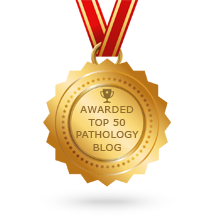Dear Readers,
I am excited to announce that we are celebrating our 777th case!
In honor of this milestone, we have a selection of 3 helminth eggs for you to identify. You win the parasite jackpot if you can get all three. There is an 'easy' and 'hard' version, so you get to take your pick.EASY VERSION
Egg 1 (50 micrometers long)










24 comments:
Trichuris.. Ascaris fertilized egg.. Taenia egg
Hard.. All 3 artifacts
Easy:
1. Trichuris
2. Ascaris
3. Taenia
Hard:
1. Artifact
2. Acanthocephalan (likely Macracanthorhynchus)
3. Artifact
Easy
1. Trichuris trichiura
2. Ascaris
3. Taenia
Hard
1,3 artifacts
So far I believe that the first egg is of Bertiella species. The second one is Macracanthorhynchus hirudinaceus. I don’t have the identification of the third one yet.
Florida Fan
For sure the easy three are classic: Trichuris trichura, Ascaris lumbricoides/suis, and Taenia spp.
Florida Fan
Splendid idea to do a quiz Dr. Pritt!
Many congratulations!!!
As for the answers to both quizzes:
EASY:
1. Trichuris trichiura
2. Ascaris lumbricoides (fertile egg)
3. Taenia spp. egg
HARD:
1. Bertiella egg
2. Macracanthorhynchus egg
3. egg capsule of Dipylidium caninum (with eggs inside of the dark area)
This is so amzing
Easy ones:
1. Trichuris
2. Ascaris
3. Taenia
Hard ones
1. Bertiella- typical pyriform structure within the egg
2. Egg of Acanthocephalan
3. The hint says it all- Dipylidium caninum
Easy-
1. Trichuris trichiura egg
2. Ascaris lumbroides egg (fertilised)
3. Taenia spp eggs
Hard-
Artifacts
Spores
Idzi: I see what you mean, just the third object is so darkly stained that we can’t clearly visualize the internal structure. This confuses me.
Florida Fan
Easy:
1. Trichuris trichiura egg
2. Ascaris lumbricoides egg
3. Taenia species egg
Easy:
1. Trichuris trichiura
2. Ascaris lumbricoides
3. Taenia species
Hard:
1. Bertiella
2. Acanthocephalan egg
3. Stumped. The picture says comes from 4 mm structure but Dipylidium egg packets aren't that big. Waiting for the answer.
The proglotids of D. caninum when freshly passed out of my Scooby can measure up to 12*3 mm in size. Very shortly thereafter, they shrivel down to 4-6*1-2 mm and this size of a small rice grain is what we mostly find in the lab. It’s just the dark brown color rendered the internal structure not clearly visible and this is the challenge. Anyway this is a very good educational example otherwise the case would be a piece of cake.
Florida Fan
Easy:
1. Trichuris trichiura egg.
2. Ascaris lumbricoides egg.
3. Taenia sp egg.
Hard:
1. Bertiella sp egg.
2. Macracanthorhynchus or Moniliformis egg.
3. Inermicapsifer madagascariensis egg.
Have my doubts, but wish it's ok.
-HLCM fan
Waaauw! That’s amazing HLCM fan, you’re 100% right imo!
That last one is indeed Inermicapsifer instead of Dipylidium.
The size of 4mm fits right in with Inermicapsifer proglottids - better than with Dipylidium! Also the dark interior fits better…
Nice! Congrats to HLCM fan!
For the hard one nr.2 : moniliformis eggs would be more clear I think, so I’d go really for Macracanthorhynchus egg…
Another PS: Inermicapsifer and Raillietina cannot be morphologically differentiated without checking the scolex, so Railliettina sp. remains in the differential...
My Final answers:
EASY:
1. Trichuris trichiura egg
2. Ascaris lumbricoides (fertile egg)
3. Taenia spp. egg
HARD:
1. Bertiella sp. egg
2. Macracanthorhynchus sp. egg
3. egg capsule of Inermicapsifer sp. or Raillietina sp. (with eggs inside of the dark area)
Congrats on 777!!! It's amazing the variations of things and presentations that come up -- very clever putting this blog together.
As a mere people pathologist on the easy list I've seen and recognize trichuris, ascaris and taenia. On the hard list, if actually presented with an example, would have to give up and call in the pros - prelim "likely parasite present, ID to follow".
1 Trichuris
2 Ascaris
3 Taenia spp
4-6 hard no pathogenic parasites seen
/Patrik
Idzi: After reading all the answers and weighing the possibilities, I believe the answer is Inermicapsipher rather than Raillietina. So take your “leap of faith” “si Tu crois en toi”. 😀 Florida Fan
Florida Fan: sorry, I’m sticking with both options Florida Fan!!!
😅😉
I truly think you cannot make the distinction reliably based only on the egg capsule, I think you really need to look at the scolex (Raillietina=armed with hooks, while Inermicapsifer=unarmed).
1. Trichuris Trichiura egg
2. Ascaris Lumbericoides egg
3. Taenia SP egg-tapeworm
Easy:
1. Trichuris trichiura egg
2. Ascaris lumbricoides egg
3. Taenia sp. egg
Hard:
1. Bertiella sp. egg
2. Macracanthorhynchus sp. egg
3. egg capsule of Inermicapsifer/Raillietina.
Easy:
1. Trichuris trichiura egg
2. Ascaris lumbricoides egg
3. Taenia sp. egg
Hard:
1. Bertiella sp. egg
2. Macracanthorhynchus sp. egg
3. egg capsule of Inermicapsifer/Raillietina
1- Trichuris trichiura
2- Ascaris lumbricoides
3- Tenia sp. egg
Post a Comment